#Applications of Data Science in Engineering
Explore tagged Tumblr posts
Text
Machine learning and the microscope
New Post has been published on https://thedigitalinsider.com/machine-learning-and-the-microscope/
Machine learning and the microscope


With recent advances in imaging, genomics and other technologies, the life sciences are awash in data. If a biologist is studying cells taken from the brain tissue of Alzheimer’s patients, for example, there could be any number of characteristics they want to investigate — a cell’s type, the genes it’s expressing, its location within the tissue, or more. However, while cells can now be probed experimentally using different kinds of measurements simultaneously, when it comes to analyzing the data, scientists usually can only work with one type of measurement at a time.
Working with “multimodal” data, as it’s called, requires new computational tools, which is where Xinyi Zhang comes in.
The fourth-year MIT PhD student is bridging machine learning and biology to understand fundamental biological principles, especially in areas where conventional methods have hit limitations. Working in the lab of MIT Professor Caroline Uhler in the Department of Electrical Engineering and Computer Science and the Institute for Data, Systems, and Society, and collaborating with researchers at the Eric and Wendy Schmidt Center at the Broad Institute and elsewhere, Zhang has led multiple efforts to build computational frameworks and principles for understanding the regulatory mechanisms of cells.
“All of these are small steps toward the end goal of trying to answer how cells work, how tissues and organs work, why they have disease, and why they can sometimes be cured and sometimes not,” Zhang says.
The activities Zhang pursues in her down time are no less ambitious. The list of hobbies she has taken up at the Institute include sailing, skiing, ice skating, rock climbing, performing with MIT’s Concert Choir, and flying single-engine planes. (She earned her pilot’s license in November 2022.)
“I guess I like to go to places I’ve never been and do things I haven’t done before,” she says with signature understatement.
Uhler, her advisor, says that Zhang’s quiet humility leads to a surprise “in every conversation.”
“Every time, you learn something like, ‘Okay, so now she’s learning to fly,’” Uhler says. “It’s just amazing. Anything she does, she does for the right reasons. She wants to be good at the things she cares about, which I think is really exciting.”
Zhang first became interested in biology as a high school student in Hangzhou, China. She liked that her teachers couldn’t answer her questions in biology class, which led her to see it as the “most interesting” topic to study.
Her interest in biology eventually turned into an interest in bioengineering. After her parents, who were middle school teachers, suggested studying in the United States, she majored in the latter alongside electrical engineering and computer science as an undergraduate at the University of California at Berkeley.
Zhang was ready to dive straight into MIT’s EECS PhD program after graduating in 2020, but the Covid-19 pandemic delayed her first year. Despite that, in December 2022, she, Uhler, and two other co-authors published a paper in Nature Communications.
The groundwork for the paper was laid by Xiao Wang, one of the co-authors. She had previously done work with the Broad Institute in developing a form of spatial cell analysis that combined multiple forms of cell imaging and gene expression for the same cell while also mapping out the cell’s place in the tissue sample it came from — something that had never been done before.
This innovation had many potential applications, including enabling new ways of tracking the progression of various diseases, but there was no way to analyze all the multimodal data the method produced. In came Zhang, who became interested in designing a computational method that could.
The team focused on chromatin staining as their imaging method of choice, which is relatively cheap but still reveals a great deal of information about cells. The next step was integrating the spatial analysis techniques developed by Wang, and to do that, Zhang began designing an autoencoder.
Autoencoders are a type of neural network that typically encodes and shrinks large amounts of high-dimensional data, then expand the transformed data back to its original size. In this case, Zhang’s autoencoder did the reverse, taking the input data and making it higher-dimensional. This allowed them to combine data from different animals and remove technical variations that were not due to meaningful biological differences.
In the paper, they used this technology, abbreviated as STACI, to identify how cells and tissues reveal the progression of Alzheimer’s disease when observed under a number of spatial and imaging techniques. The model can also be used to analyze any number of diseases, Zhang says.
Given unlimited time and resources, her dream would be to build a fully complete model of human life. Unfortunately, both time and resources are limited. Her ambition isn’t, however, and she says she wants to keep applying her skills to solve the “most challenging questions that we don’t have the tools to answer.”
She’s currently working on wrapping up a couple of projects, one focused on studying neurodegeneration by analyzing frontal cortex imaging and another on predicting protein images from protein sequences and chromatin imaging.
“There are still many unanswered questions,” she says. “I want to pick questions that are biologically meaningful, that help us understand things we didn’t know before.”
#2022#amazing#Analysis#Animals#applications#Autoencoders#bioengineering#Biology#Brain#Broad Institute#cell#Cells#China#chromatin#communications#computer#Computer Science#covid#data#deal#december#Disease#Diseases#engine#engineering#form#Forms#Fundamental#gene expression#genes
2 notes
·
View notes
Text
Consultant – Labour Migration
Consultant – Labour Migration Location: Ankara, Turkey Application Deadline: 3 July 2025, 11:59 PM Contract Type: Consultancy (up to 11 months) Job Category: Labour Migration, Employment Policy, Capacity Development Education Required: Bachelor’s degree minimum (Master’s or PhD preferred) Languages Required: English and Turkish Organizational Unit: International Organization for Migration (IOM) –…
#Careers with the UN.#Entry-Level UN Jobs#Freelance UN Jobs#How to Apply for UN Jobs#Internship Opportunities with the UN#Part-Time UN Jobs#Remote UN Jobs#Temporary UN Jobs#UN Administration Jobs#UN Communications Jobs.UN Jobs#UN Communications Officer Jobs#UN Consultancy Jobs#UN Contract Jobs#UN Data Analyst Jobs#UN Data Science Jobs#UN Employment Opportunities#UN Engineering Jobs#UN Environmental Jobs#UN Field Officer Jobs#UN Health and Safety Jobs#UN Hiring#UN HR Jobs#UN Human Rights Officer Jobs#UN Humanitarian Jobs#UN International Jobs#UN Internship Vacancies.UN Project Manager Jobs#UN IT Jobs#UN Job Openings#UN Job Opportunities#UN Jobs Application Process
0 notes
Text

BTech CSE: Your Gateway to High-Demand Tech Careers
Apply now for admission and avail the Early Bird Offer
In the digital age, a BTech in Computer Science & Engineering (CSE) is one of the most sought-after degrees, offering unmatched career opportunities across industries. From software development to artificial intelligence, the possibilities are endless for CSE graduates.
Top Job Opportunities for BTech CSE Graduates
Software Developer: Design and develop innovative applications and systems.
Data Scientist: Analyze big data to drive business decisions.
Cybersecurity Analyst: Safeguard organizations from digital threats.
AI/ML Engineer: Lead the way in artificial intelligence and machine learning.
Cloud Architect: Build and maintain cloud-based infrastructure for global organizations.
Why Choose Brainware University for BTech CSE?
Brainware University provides a cutting-edge curriculum, hands-on training, and access to industry-leading tools. Our dedicated placement cell ensures you’re job-ready, connecting you with top recruiters in tech.
👉 Early Bird Offer: Don’t wait! Enroll now and take the first step toward a high-paying, future-ready career in CSE.
Your journey to becoming a tech leader starts here!
#n the digital age#a BTech in Computer Science & Engineering (CSE) is one of the most sought-after degrees#offering unmatched career opportunities across industries. From software development to artificial intelligence#the possibilities are endless for CSE graduates.#Top Job Opportunities for BTech CSE Graduates#Software Developer: Design and develop innovative applications and systems.#Data Scientist: Analyze big data to drive business decisions.#Cybersecurity Analyst: Safeguard organizations from digital threats.#AI/ML Engineer: Lead the way in artificial intelligence and machine learning.#Cloud Architect: Build and maintain cloud-based infrastructure for global organizations.#Why Choose Brainware University for BTech CSE?#Brainware University provides a cutting-edge curriculum#hands-on training#and access to industry-leading tools. Our dedicated placement cell ensures you’re job-ready#connecting you with top recruiters in tech.#👉 Early Bird Offer: Don’t wait! Enroll now and take the first step toward a high-paying#future-ready career in CSE.#Your journey to becoming a tech leader starts here!#BTechCSE#BrainwareUniversity#TechCareers#SoftwareEngineering#AIJobs#EarlyBirdOffer#DataScience#FutureOfTech#Placements
1 note
·
View note
Text
Build AI Tools for Money: Simple Developers Guide
Learn how developers can create and sell AI tools or APIs for profit. Discover steps to identify problems, build solutions, monetize effectively, and grow your AI business.
The world of artificial intelligence (AI) is booming, and developers are uniquely positioned to take advantage of this trend. Creating and selling AI tools or APIs is one of the most lucrative ways to turn your coding skills into a business. Whether you’re solving a niche problem or building tools for broader use, there are endless opportunities in this space. Table of Contents What Are AI Tools…
#AI#Application Development#Business Growth#Cloud Computing#Cognitive Computing#Creative Tools#Data Science#Machine Learning#Software Development#Software Engineering
0 notes
Text
The Generative AI Revolution: Transforming Industries with Brillio
The realm of artificial intelligence is experiencing a paradigm shift with the emergence of generative AI. Unlike traditional AI models focused on analyzing existing data, generative AI takes a leap forward by creating entirely new content. The generative ai technology unlocks a future brimming with possibilities across diverse industries. Let's read about the transformative power of generative AI in various sectors:
1. Healthcare Industry:
AI for Network Optimization: Generative AI can optimize healthcare networks by predicting patient flow, resource allocation, etc. This translates to streamlined operations, improved efficiency, and potentially reduced wait times.
Generative AI for Life Sciences & Pharma: Imagine accelerating drug discovery by generating new molecule structures with desired properties. Generative AI can analyze vast datasets to identify potential drug candidates, saving valuable time and resources in the pharmaceutical research and development process.
Patient Experience Redefined: Generative AI can personalize patient communication and education. Imagine chatbots that provide tailored guidance based on a patient's medical history or generate realistic simulations for medical training.
Future of AI in Healthcare: Generative AI has the potential to revolutionize disease diagnosis and treatment plans by creating synthetic patient data for anonymized medical research and personalized drug development based on individual genetic profiles.
2. Retail Industry:
Advanced Analytics with Generative AI: Retailers can leverage generative AI to analyze customer behavior and predict future trends. This allows for targeted marketing campaigns, optimized product placement based on customer preferences, and even the generation of personalized product recommendations.
AI Retail Merchandising: Imagine creating a virtual storefront that dynamically adjusts based on customer demographics and real-time buying patterns. Generative AI can optimize product assortments, recommend complementary items, and predict optimal pricing strategies.
Demystifying Customer Experience: Generative AI can analyze customer feedback and social media data to identify emerging trends and potential areas of improvement in the customer journey. This empowers retailers to take proactive steps to enhance customer satisfaction and loyalty.
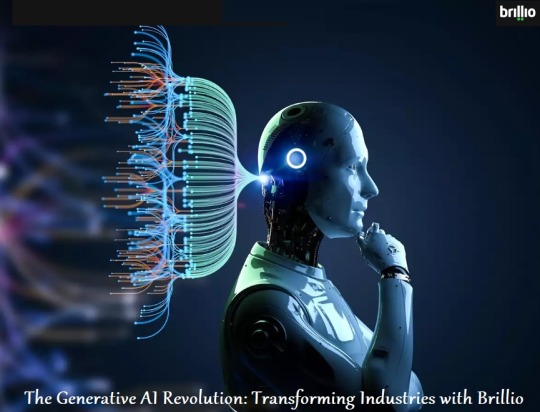
3. Finance Industry:
Generative AI in Banking: Generative AI can streamline loan application processes by automatically generating personalized loan offers and risk assessments. This reduces processing time and improves customer service efficiency.
4. Technology Industry:
Generative AI for Software Testing: Imagine automating the creation of large-scale test datasets for various software functionalities. Generative AI can expedite the testing process, identify potential vulnerabilities more effectively, and contribute to faster software releases.
Generative AI for Hi-Tech: This technology can accelerate innovation in various high-tech fields by creating novel designs for microchips, materials, or even generating code snippets to enhance existing software functionalities.
Generative AI for Telecom: Generative AI can optimize network performance by predicting potential obstruction and generating data patterns to simulate network traffic scenarios. This allows telecom companies to proactively maintain and improve network efficiency.
5. Generative AI Beyond Industries:
GenAI Powered Search Engine: Imagine a search engine that understands context and intent, generating relevant and personalized results tailored to your specific needs. This eliminates the need to sift through mountains of irrelevant information, enhancing the overall search experience.
Product Engineering with Generative AI: Design teams can leverage generative AI to create new product prototypes, explore innovative design possibilities, and accelerate the product development cycle.
Machine Learning with Generative AI: Generative AI can be used to create synthetic training data for machine learning models, leading to improved accuracy and enhanced efficiency.
Global Data Studio with Generative AI: Imagine generating realistic and anonymized datasets for data analysis purposes. This empowers researchers, businesses, and organizations to unlock insights from data while preserving privacy.
6. Learning & Development with Generative AI:
L&D Shares with Generative AI: This technology can create realistic simulations and personalized training modules tailored to individual learning styles and skill gaps. Generative AI can personalize the learning experience, fostering deeper engagement and knowledge retention.
HFS Generative AI: Generative AI can be used to personalize learning experiences for employees in the human resources and financial services sector. This technology can create tailored training programs for onboarding, compliance training, and skill development.
7. Generative AI for AIOps:
AIOps (Artificial Intelligence for IT Operations) utilizes AI to automate and optimize IT infrastructure management. Generative AI can further enhance this process by predicting potential IT issues before they occur, generating synthetic data for simulating scenarios, and optimizing remediation strategies.
Conclusion:
The potential of generative AI is vast, with its applications continuously expanding across industries. As research and development progress, we can expect even more groundbreaking advancements that will reshape the way we live, work, and interact with technology.
Reference- https://articlescad.com/the-generative-ai-revolution-transforming-industries-with-brillio-231268.html
#google generative ai services#ai for network optimization#generative ai for life sciences#generative ai in pharma#generative ai in banking#generative ai in software testing#ai technology in healthcare#future of ai in healthcare#advanced analytics in retail#ai retail merchandising#generative ai for telecom#generative ai for hi-tech#generative ai for retail#learn demystifying customer experience#generative ai for healthcare#product engineering services with Genai#accelerate application modernization#patient experience with generative ai#genai powered search engine#machine learning solution with ai#global data studio with gen ai#l&d shares with gen ai technology#hfs generative ai#generative ai for aiops
0 notes
Text
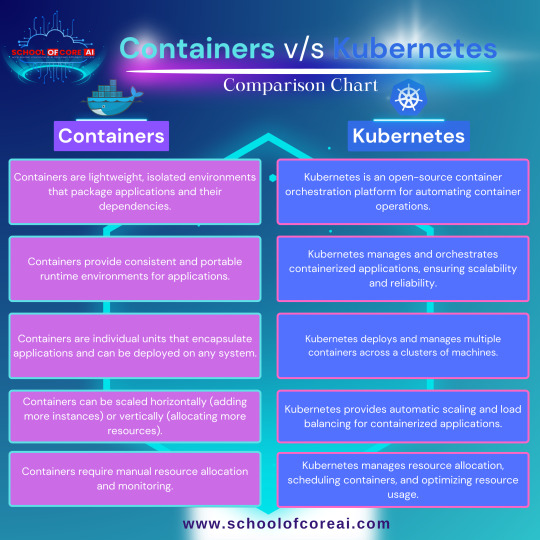
Visit here learn these Tools - Online or Offline
#machine learning#linux#docker#kubernetes#computer science#programming#ai tools#software engineering#application#education#career#datascience#data analytics#artificial intelligence
1 note
·
View note
Text
"When a severe water shortage hit the Indian city of Kozhikode in the state of Kerala, a group of engineers turned to science fiction to keep the taps running.
Like everyone else in the city, engineering student Swapnil Shrivastav received a ration of two buckets of water a day collected from India’s arsenal of small water towers.
It was a ‘watershed’ moment for Shrivastav, who according to the BBC had won a student competition four years earlier on the subject of tackling water scarcity, and armed with a hypothetical template from the original Star Wars films, Shrivastav and two partners set to work harvesting water from the humid air.
“One element of inspiration was from Star Wars where there’s an air-to-water device. I thought why don’t we give it a try? It was more of a curiosity project,” he told the BBC.
According to ‘Wookiepedia’ a ‘moisture vaporator’ is a device used on moisture farms to capture water from a dry planet’s atmosphere, like Tatooine, where protagonist Luke Skywalker grew up.
This fictional device functions according to Star Wars lore by coaxing moisture from the air by means of refrigerated condensers, which generate low-energy ionization fields. Captured water is then pumped or gravity-directed into a storage cistern that adjusts its pH levels. Vaporators are capable of collecting 1.5 liters of water per day.

Pictured: Moisture vaporators on the largely abandoned Star Wars film set of Mos Espa, in Tunisia
If science fiction authors could come up with the particulars of such a device, Shrivastav must have felt his had a good chance of succeeding. He and colleagues Govinda Balaji and Venkatesh Raja founded Uravu Labs, a Bangalore-based startup in 2019.
Their initial offering is a machine that converts air to water using a liquid desiccant. Absorbing moisture from the air, sunlight or renewable energy heats the desiccant to around 100°F which releases the captured moisture into a chamber where it’s condensed into drinking water.
The whole process takes 12 hours but can produce a staggering 2,000 liters, or about 500 gallons of drinking-quality water per day. [Note: that IS staggering! That's huge!!] Uravu has since had to adjust course due to the cost of manufacturing and running the machines—it’s just too high for civic use with current materials technology.
“We had to shift to commercial consumption applications as they were ready to pay us and it’s a sustainability driver for them,” Shrivastav explained. This pivot has so far been enough to keep the start-up afloat, and they produce water for 40 different hospitality clients.
Looking ahead, Shrivastav, Raja, and Balaji are planning to investigate whether the desiccant can be made more efficient; can it work at a lower temperature to reduce running costs, or is there another material altogether that might prove more cost-effective?
They’re also looking at running their device attached to data centers in a pilot project that would see them utilize the waste heat coming off the centers to heat the desiccant."
-via Good News Network, May 30, 2024
#water#india#kerala#Kozhikode#science and technology#clean water#water access#drinking water#drought#climate change#climate crisis#climate action#climate adaptation#green tech#sustainability#water shortage#good news#hope#star wars#tatooine
1K notes
·
View notes
Text
Conspiratorialism as a material phenomenon

I'll be in TUCSON, AZ from November 8-10: I'm the GUEST OF HONOR at the TUSCON SCIENCE FICTION CONVENTION.

I think it behooves us to be a little skeptical of stories about AI driving people to believe wrong things and commit ugly actions. Not that I like the AI slop that is filling up our social media, but when we look at the ways that AI is harming us, slop is pretty low on the list.
The real AI harms come from the actual things that AI companies sell AI to do. There's the AI gun-detector gadgets that the credulous Mayor Eric Adams put in NYC subways, which led to 2,749 invasive searches and turned up zero guns:
https://www.cbsnews.com/newyork/news/nycs-subway-weapons-detector-pilot-program-ends/
Any time AI is used to predict crime – predictive policing, bail determinations, Child Protective Services red flags – they magnify the biases already present in these systems, and, even worse, they give this bias the veneer of scientific neutrality. This process is called "empiricism-washing," and you know you're experiencing it when you hear some variation on "it's just math, math can't be racist":
https://pluralistic.net/2020/06/23/cryptocidal-maniacs/#phrenology
When AI is used to replace customer service representatives, it systematically defrauds customers, while providing an "accountability sink" that allows the company to disclaim responsibility for the thefts:
https://pluralistic.net/2024/04/23/maximal-plausibility/#reverse-centaurs
When AI is used to perform high-velocity "decision support" that is supposed to inform a "human in the loop," it quickly overwhelms its human overseer, who takes on the role of "moral crumple zone," pressing the "OK" button as fast as they can. This is bad enough when the sacrificial victim is a human overseeing, say, proctoring software that accuses remote students of cheating on their tests:
https://pluralistic.net/2022/02/16/unauthorized-paper/#cheating-anticheat
But it's potentially lethal when the AI is a transcription engine that doctors have to use to feed notes to a data-hungry electronic health record system that is optimized to commit health insurance fraud by seeking out pretenses to "upcode" a patient's treatment. Those AIs are prone to inventing things the doctor never said, inserting them into the record that the doctor is supposed to review, but remember, the only reason the AI is there at all is that the doctor is being asked to do so much paperwork that they don't have time to treat their patients:
https://apnews.com/article/ai-artificial-intelligence-health-business-90020cdf5fa16c79ca2e5b6c4c9bbb14
My point is that "worrying about AI" is a zero-sum game. When we train our fire on the stuff that isn't important to the AI stock swindlers' business-plans (like creating AI slop), we should remember that the AI companies could halt all of that activity and not lose a dime in revenue. By contrast, when we focus on AI applications that do the most direct harm – policing, health, security, customer service – we also focus on the AI applications that make the most money and drive the most investment.
AI hasn't attracted hundreds of billions in investment capital because investors love AI slop. All the money pouring into the system – from investors, from customers, from easily gulled big-city mayors – is chasing things that AI is objectively very bad at and those things also cause much more harm than AI slop. If you want to be a good AI critic, you should devote the majority of your focus to these applications. Sure, they're not as visually arresting, but discrediting them is financially arresting, and that's what really matters.
All that said: AI slop is real, there is a lot of it, and just because it doesn't warrant priority over the stuff AI companies actually sell, it still has cultural significance and is worth considering.
AI slop has turned Facebook into an anaerobic lagoon of botshit, just the laziest, grossest engagement bait, much of it the product of rise-and-grind spammers who avidly consume get rich quick "courses" and then churn out a torrent of "shrimp Jesus" and fake chainsaw sculptures:
https://www.404media.co/email/1cdf7620-2e2f-4450-9cd9-e041f4f0c27f/
For poor engagement farmers in the global south chasing the fractional pennies that Facebook shells out for successful clickbait, the actual content of the slop is beside the point. These spammers aren't necessarily tuned into the psyche of the wealthy-world Facebook users who represent Meta's top monetization subjects. They're just trying everything and doubling down on anything that moves the needle, A/B splitting their way into weird, hyper-optimized, grotesque crap:
https://www.404media.co/facebook-is-being-overrun-with-stolen-ai-generated-images-that-people-think-are-real/
In other words, Facebook's AI spammers are laying out a banquet of arbitrary possibilities, like the letters on a Ouija board, and the Facebook users' clicks and engagement are a collective ideomotor response, moving the algorithm's planchette to the options that tug hardest at our collective delights (or, more often, disgusts).
So, rather than thinking of AI spammers as creating the ideological and aesthetic trends that drive millions of confused Facebook users into condemning, praising, and arguing about surreal botshit, it's more true to say that spammers are discovering these trends within their subjects' collective yearnings and terrors, and then refining them by exploring endlessly ramified variations in search of unsuspected niches.
(If you know anything about AI, this may remind you of something: a Generative Adversarial Network, in which one bot creates variations on a theme, and another bot ranks how closely the variations approach some ideal. In this case, the spammers are the generators and the Facebook users they evince reactions from are the discriminators)
https://en.wikipedia.org/wiki/Generative_adversarial_network
I got to thinking about this today while reading User Mag, Taylor Lorenz's superb newsletter, and her reporting on a new AI slop trend, "My neighbor’s ridiculous reason for egging my car":
https://www.usermag.co/p/my-neighbors-ridiculous-reason-for
The "egging my car" slop consists of endless variations on a story in which the poster (generally a figure of sympathy, canonically a single mother of newborn twins) complains that her awful neighbor threw dozens of eggs at her car to punish her for parking in a way that blocked his elaborate Hallowe'en display. The text is accompanied by an AI-generated image showing a modest family car that has been absolutely plastered with broken eggs, dozens upon dozens of them.
According to Lorenz, variations on this slop are topping very large Facebook discussion forums totalling millions of users, like "Movie Character…,USA Story, Volleyball Women, Top Trends, Love Style, and God Bless." These posts link to SEO sites laden with programmatic advertising.
The funnel goes:
i. Create outrage and hence broad reach;
ii, A small percentage of those who see the post will click through to the SEO site;
iii. A small fraction of those users will click a low-quality ad;
iv. The ad will pay homeopathic sub-pennies to the spammer.
The revenue per user on this kind of scam is next to nothing, so it only works if it can get very broad reach, which is why the spam is so designed for engagement maximization. The more discussion a post generates, the more users Facebook recommends it to.
These are very effective engagement bait. Almost all AI slop gets some free engagement in the form of arguments between users who don't know they're commenting an AI scam and people hectoring them for falling for the scam. This is like the free square in the middle of a bingo card.
Beyond that, there's multivalent outrage: some users are furious about food wastage; others about the poor, victimized "mother" (some users are furious about both). Not only do users get to voice their fury at both of these imaginary sins, they can also argue with one another about whether, say, food wastage even matters when compared to the petty-minded aggression of the "perpetrator." These discussions also offer lots of opportunity for violent fantasies about the bad guy getting a comeuppance, offers to travel to the imaginary AI-generated suburb to dole out a beating, etc. All in all, the spammers behind this tedious fiction have really figured out how to rope in all kinds of users' attention.
Of course, the spammers don't get much from this. There isn't such a thing as an "attention economy." You can't use attention as a unit of account, a medium of exchange or a store of value. Attention – like everything else that you can't build an economy upon, such as cryptocurrency – must be converted to money before it has economic significance. Hence that tooth-achingly trite high-tech neologism, "monetization."
The monetization of attention is very poor, but AI is heavily subsidized or even free (for now), so the largest venture capital and private equity funds in the world are spending billions in public pension money and rich peoples' savings into CO2 plumes, GPUs, and botshit so that a bunch of hustle-culture weirdos in the Pacific Rim can make a few dollars by tricking people into clicking through engagement bait slop – twice.
The slop isn't the point of this, but the slop does have the useful function of making the collective ideomotor response visible and thus providing a peek into our hopes and fears. What does the "egging my car" slop say about the things that we're thinking about?
Lorenz cites Jamie Cohen, a media scholar at CUNY Queens, who points out that subtext of this slop is "fear and distrust in people about their neighbors." Cohen predicts that "the next trend, is going to be stranger and more violent.”
This feels right to me. The corollary of mistrusting your neighbors, of course, is trusting only yourself and your family. Or, as Margaret Thatcher liked to say, "There is no such thing as society. There are individual men and women and there are families."
We are living in the tail end of a 40 year experiment in structuring our world as though "there is no such thing as society." We've gutted our welfare net, shut down or privatized public services, all but abolished solidaristic institutions like unions.
This isn't mere aesthetics: an atomized society is far more hospitable to extreme wealth inequality than one in which we are all in it together. When your power comes from being a "wise consumer" who "votes with your wallet," then all you can do about the climate emergency is buy a different kind of car – you can't build the public transit system that will make cars obsolete.
When you "vote with your wallet" all you can do about animal cruelty and habitat loss is eat less meat. When you "vote with your wallet" all you can do about high drug prices is "shop around for a bargain." When you vote with your wallet, all you can do when your bank forecloses on your home is "choose your next lender more carefully."
Most importantly, when you vote with your wallet, you cast a ballot in an election that the people with the thickest wallets always win. No wonder those people have spent so long teaching us that we can't trust our neighbors, that there is no such thing as society, that we can't have nice things. That there is no alternative.
The commercial surveillance industry really wants you to believe that they're good at convincing people of things, because that's a good way to sell advertising. But claims of mind-control are pretty goddamned improbable – everyone who ever claimed to have managed the trick was lying, from Rasputin to MK-ULTRA:
https://pluralistic.net/HowToDestroySurveillanceCapitalism
Rather than seeing these platforms as convincing people of things, we should understand them as discovering and reinforcing the ideology that people have been driven to by material conditions. Platforms like Facebook show us to one another, let us form groups that can imperfectly fill in for the solidarity we're desperate for after 40 years of "no such thing as society."
The most interesting thing about "egging my car" slop is that it reveals that so many of us are convinced of two contradictory things: first, that everyone else is a monster who will turn on you for the pettiest of reasons; and second, that we're all the kind of people who would stick up for the victims of those monsters.

Tor Books as just published two new, free LITTLE BROTHER stories: VIGILANT, about creepy surveillance in distance education; and SPILL, about oil pipelines and indigenous landback.


If you'd like an essay-formatted version of this post to read or share, here's a link to it on pluralistic.net, my surveillance-free, ad-free, tracker-free blog:
https://pluralistic.net/2024/10/29/hobbesian-slop/#cui-bono

Image: Cryteria (modified) https://commons.wikimedia.org/wiki/File:HAL9000.svg
CC BY 3.0 https://creativecommons.org/licenses/by/3.0/deed.en
#pluralistic#taylor lorenz#conspiratorialism#conspiracy fantasy#mind control#a paradise built in hell#solnit#ai slop#ai#disinformation#materialism#doppelganger#naomi klein
308 notes
·
View notes
Text
What is Dataflow? Part 2: Diagrams
This is the second part of a couple of posts about Dataflow, particularly why it's important for the world going forward and relating to the Crowd Strike IT disaster.
Read the first part here.
Before I get into this one today, I wanted to address a couple of things.
Firstly, Dataflow is something that nearly every single person can understand. You do NOT:
Need to have a degree in Computing Science
Need to work in IT
Need to be a data analyst / Spreadsheet master
If any of you see the word 'Data' and feel your eyes glazing over, try and snap out of it because, if you're anything like me, Dataflow is much more approachable as a concept.
Secondly, what do I mean by IT?
Traditionally in most of our media the all-encompassing 'IT department' handles everything to do with technology. But every business works differently and there are many job titles with lots of crossover.
For example, you can be an infrastructure engineer where your focus is on building and maintaining the IT infrastructure that connects your organisation internally and externally. This is a completely different role from an Application Portfolio Manager who is tasked with looking after the Applications used in business processes.
Both are technical people and come under the banner of 'IT' - but their roles are focused in different areas. So just bear that in mind!
Now that's out of the way, let's begin! This one will be a little bit deeper, and questions welcome!
An Intro to Diagrams
You probably do not need a history of why pictures are important to the human race but to cover our bases, ever since we put traced our hands on a cave wall we have been using pictures to communicate.

Jump forward in time and you have engineers like Leonardo Da Vinci drafting engineering schematics.

You get the idea, humans have been creating diagrams (Pictures) for thousands of years. Centuries of refinement and we have much more modern variations.
And there's one main reason why diagrams are important: They are a Common Language.
In this context, a Common Language helps bridge a language gap between disciplines as well as a linguistic gap. A Spanish electrician and a German electrician should be able to refer to the same diagram and understand each other, even if they don't know each other's language.
The reason they can do this is because they're are international standards which govern how electrical diagrams are created.
A Common Language for Digital?
Here's an image I've shown to clients from governments and institutions to global organisations.

Everything around us, from the products we use to the bridges we drive over and the buildings we live, work, enjoy and shop in had diagrams backing them.
You would not build a skyscraper without a structural engineering diagram, you would not build an extension on your house if an architect couldn't produce a blueprint.
Why is there not an equivalent for the Digital World and for Dataflow?
Where is the Digital Common Language?
This is the bit where the lightbulb goes on in a lot of people's heads. Because, as I mentioned in Part 1, the flow of data is the flow of information and knowledge. And the common mistake is that people think of dataflow, and only ever think about the technology.
Dataflow is the flow of information between People, Business Processes *and* Technology Assets.
It is not reserved to Technology specialists. When you look at the flow of data, you need to understand the People (Stakeholders) at the top, the processes that they perform (and the processes which use the data) and the technology assets that support that data.
The reason why this is important is because it puts the entire organisation in context.
It is something that modern businesses fail to do. They might have flow charts and network diagrams, and these are 'alright' in specific contexts, but they fall to pieces when they lack the context of the full organisation.
For example, here is a Network Diagram. It is probably of *some* value to technical personnel who work in infrastructure. Worth bearing in mind, some organisations don't even have something like this.

To be absolutely clear, this diagram will hold some value for some people within the organisation. I'm not saying it's completely useless. But for almost everyone else, it is entirely out of context, especially for any non-technical people.
So it doesn't help non-technical people understand why all of these assets are important, and it doesn't help infrastructure teams articulate the importance of any of these assets.
What happens if one of those switches or routers fails? What's the impact on the organisation? Who is affected? The diagram above does not answer those questions.
On the other side of the business we have process diagrams (aka workflow diagrams) which look like this.

Again we run into the same problem - This is maybe useful for some people working up at the process layer, but even then it doesn't provide context for the stakeholders involved (Are there multiple people/departments involved throughout) and it doesn't provide any context for technical personnel who are responsible for maintaining the technology that supports this process.
In short, nobody has the big picture because there is not a common language between Business & IT.
Conclusion
So what do we do? Well we need to have a Common Language between Business & IT. While we need people with cross-functional knowledge, we also need a common language (or common framework) for both sides of the organisation to actually understand each other.
Otherwise you get massively siloed departments completely winging their disaster recovery strategies when things like Crowd Strike goes down.
Senior Management will be asked questions about what needs to be prioritised and they won't have answers because they aren't thinking in terms of Dataflow.
It's not just 'We need to turn on everything again' - It's a question of priorities.
Thing is, there's a relatively simple way to do it, in a way that looking at any engineering diagram feels simple but actually has had decades/centuries of thought behind it. It almost feels like complete common sense.
I'll save it for Part 3 if you're interested in me continuing and I'll make a diagram of my blog.
The important thing is mapping out all the connections and dependencies, and there's not some magic button you press that does it all.
But rigorous engineering work is exactly that, you can't fudge it with a half-arsed attempt. You need to be proactive, instead of reacting whenever disaster strikes.
381 notes
·
View notes
Text
An Undergraduate Forensic Viewing of Like Minds (2006) Train Scene


Pray for me. Pray for yourself. We are one now.



Contents:
1. Introduction 2. What We Know 3. The Investigation 4. Bibliography for Nerds

1. Introduction
Some justifications first.
I'm an undergraduate stem student obssessed with many topics, including forensic studies. I just finished a complete course about forensic chemistry/tecnology/law in uni and yes, I'm a big failure of a person and was thinking about applying some of the things I've learned into Like Minds' train scene. To clarify, I'm not an experienced profissional of the field. It is to say, I've never worked in such area and had just one or two significant interaction with said profissionals and students. My considerations won't be 100% accurate, clearly, and I may mistake or ignore fundamental data and studies. I intend solely to present some interesting facts and rapidly discuss their applicability here.
Take everything I say with large grains of salt, this is mostly for my enjoyment.
Let's kill Nigel!
2. What We Know
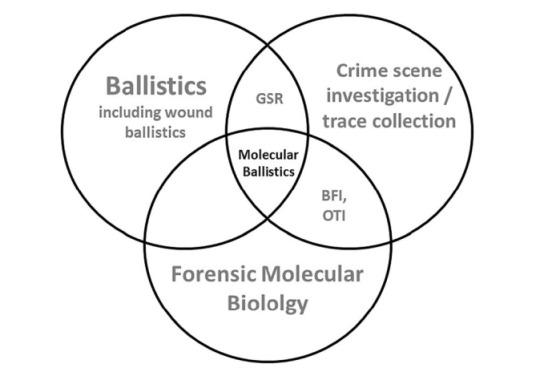
Figure 1. Visual diagram of forensic ballistics' main areas of study. Some will be mentioned here. [1]
2.1. Ballistics - Anatomy of a Discharge
Ballistics is a science field divided in three main ramifications: (1) Interior Ballistics, (2) Exterior Ballistics and (3) Terminal Ballistics. (1) studies the mechanism of a gun discharge, (2) studies the trajectory and behavior of a projectile once it is ejected from a firegun and (3) studies the damage and overall interaction of the projectile with a material structure (biological or not). [1] Ballistics experts (chemists, some engineers, law experts, etc) ocuppy themselves with many things regarding firearms, a field of work that recuries much study and understading of multiple fields of knowledge such as spectroscopy, law and general legislation, physical properties of chemical coumponds, solid state science, material science, industry production series and others. Some areas of chemistry and biology are of great importance and are commonly used complementarily.
We then understand what bullets are. The component that effectivally hits the target in these scenarios is the actual "projectile".

Figure 2. Simple structure of shotgun (left) and rifle (right) ammunition. [2]
In simple terms, they're composed by (1) a shell that holds everything together, (2) some coumpond responsable for the liberation of gas via chemical reaction and (3) some way to give the heat needed for said reaction to occur. There is a whole field of study and production of these killing objects that seeks out to balance some of their properties in different scenarios by the armamentist industry in oder to supply endless applications that constantly develops new shapes and components, so going through it all would be impossible. Regardless, all ammunition is classified by size, called "gauge" in shotguns, and "caliber" in rifles and handguns. [2]
Case: [in shotguns] It is a small cilindrical piece made out of a tube of common plastic or sturdy paper (the red/blue/colored part) that holds the multiple projectiles to be fired (shots), with a metallic base (the primer) composed of brass (copper and zinc) or steel (iron and carbon). [in rifles] The case is called cartridge case, and it is composed by brass as well. [2]
Powder (or propellant): They are usually Nitroclelullose (handguns), Nitroclelullose/Nitrogliceryn (rifles) and Nitroclelullose/Nitrogliceryn/Nitroguanidyn (long range rifles) [3]. Oversimplifying, organic molecules containing nitro groups (present in Nitroclelullose, Nitrogliceryn and Nitroguanidyn) are really unstable; these chemical groupaments are highly reactive in face of many scenarios. If enough energy is provided (by heating, or mechanical contact and pertubation) they will enter a decompostion process, breaking and reacting with their own bonds spontaneously, liberating gases such as H2O, N2 and CO2. These mentioned gases are much more stable compared to the original organic coumponds, so the atoms will "prefer" to form these species if the conditions are set (thus, a spontaneous reaction). This increases pressure inside the shell and forces the projectile to leave violently as a result of gas expansion. [4] Shotgun powder is composed by potassium nitrate, charcoal and sulfur; a mixture known as "dark powder", and it is separated from the shot (projectiles; multiple balls of steel, lead, rubber, or really anything) by a small component called "wad". The same principle explained in the decomposition of organic nitro-compounds apply for the potassium nitrate present here, but only in the presence of sulfur (easier to melt and ignite), providing the necessary heat for potassium citrate to generate the oxygen needed, resulting in charchoal's combustion. [2]
Primer: Primers are a fundamental part of any ammunition, and yet a simple one. When a firing pin from the firegun hits them, sparkles and heat will be produced, which gives the propellent all requiered energy for the chemical reaction. It is, when the action lever is pulled, the firing pin is tensioned by a spring inside the gun. When the trigger is pulled, this firing pin hits rapidly the ammunition's primer (metallic base). [5]
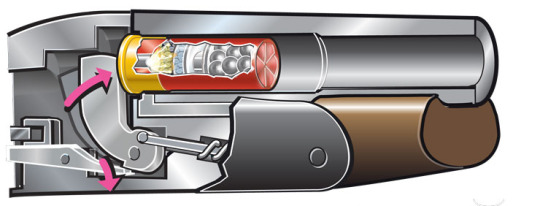
Figure 3. Shotgun firing pin scheme. [5]
The discussion of differents powders/propellents (like smokeless powder), projectiles shapes (in rifle cases) and firegun types (other than rifle and shotgun) is being ignored.
All that must be known is: the trigger pulling promotes a mechanical impact against the ammunition base, which promotes chemical reactions that liberate great amounts of gases, increasing the pressure inside the case, what will pushes the projectile(s) inside foward with great speed.
2.2. The Shotgun - Means to An End
We now restrain ourselfs to the firegun. Let us take a look on the following images:






Figures 4-9 (left to right, top to bottom). Shotguns' takes from Like Minds (2006).
Main considerations:
The shotgun used by Mr. Colbie isn't the same one used by Nigel/Alex in the train scene. We can clearly point that by the number of barrels, i.e., two barrels contaning two projectiles (killing Nigel's mother and father without visible activation) in its first appearance, and only a single one in its second appearance. Maybe this has been discussed before.
It is not a narrative problem if we have the eyes for it. Nigel's father possesses two shotguns, so we assume Nigel went back and grabbed the single-barrel one before going after Alex.
The reloading thing would be important during the bedroom scene, between the moments where John shoots his wife and Alex picks up the gun from the floor. There would be no way of aciddentially shooting Mr. Colbie wihout Alex pulling the action on the second barrel (how would he know which one of the barrels were loaded and why Mr. Colbie would only activate one of the two barrels? It appears he wasn't using the shotgun to merely scare his family). Perhaps the double barrel shotgun used has some individual firing feature, perhaps.
Also, the single barrel shotgun is the same one used by John when Alex and Nigel first accessed the hidden baseament together. This isn't of great relevance though.
After a compulsive research in gun sale sites and over 900 models of shotguns (no joking), I'm inclined to believe that Nigel's single barrel shotgun is an Era 410 GA Single Shot Break Action. My conclusions is based on Figures 6 and 9, the shotgun's best takes throughout the entire movie. The important details are: a single barrel, with rounded trigger guard that ends exactly where the wooden stock begins, by a rounded break action lever with squarish shape that leans horizontally to the receiver and a rectangular like forestock. Other smaller details are: the receiver's top shape and really curved back, the declination present on the stock and the three screws' position and size.
The engraved symbols on Colbie's receiver are sculpted by a profssional artist called "engraver", by client's demand. Therefore, these sigils are decorative and probably carry some meaning to the shotgun's real owner, so they aren't a discrepancy to worry about. The frame I acquired (Figure 9) is of poor quality and there's nothing I can read in there besides one or two letters. I've tried to watch the movie in other internet sites but it didn't help that much.
It took me forever, but here it is [6], [7]. There are also youtube videos revewing this gun in the Extra section.

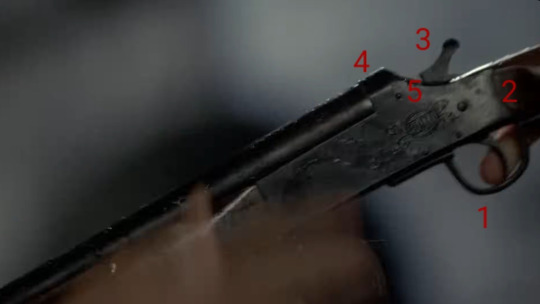


Figures 10-13. Era 410 GA Single Shot Break Action Shotgun. [6]
Note: @laurelwen successfully identified Nigel's firegun as a Boito .410. The text engraved on the shotgun's receiver in Figure 9, in fact, reads "Boito". Check it out on this post. Look up Extra Bibliography No. 7 in the shotgun's section as well.
Shotguns are a really old type of gun from the 16th century. Their mechanisms were adjusted during following centuries, but they remain still to date with an extremely simple way of function. Today, there are many types, including the single-shots and hand shotguns, much different than what was originally conceived. A break shotgun is capable of "breaking in half" for reloading, exposing its ejector/extractor and barrel interior just as many other fireguns. [8]
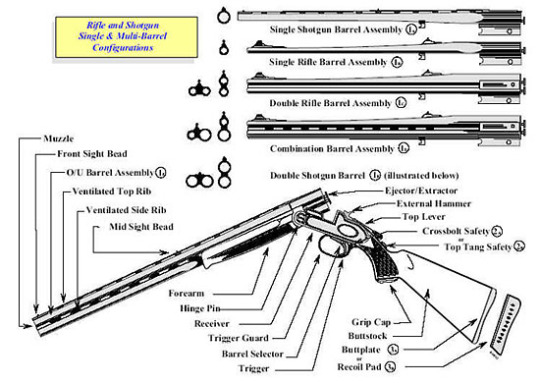
Figure 14. Break action shotgun anatomy. [9]
The Era 410 GA possesses a specially long length of barrel, which helps projectiles to achieve maximum velocity before leaving. Still, it appears from my research that this is a second hand model with low price, low demand and little historical relevance. This is the type of gun that would be bought mainly by collectors and enthusiasts; however, because of its little weight, good shooting and minimalist elegance, this firegun is not one of the worst models out there for small amateur animal hunting.
A 410 (10.41 mm, one smallest shot diameter in the market) with great pattern of dispersion after the discharge isn't bad, so at medium distances most projectiles would succesfully hit the center of a target. This is not very good when we're talking about a point-blank discharge directly at Nigel's face.
3. The Investigation

Figure 15. "If they had any evidence, I wouldn't be talking to you, would I?"
Authorities arrive at the dark, umid and isolated train tracks. Immediatly, a shocking scene: a desperate young man holding in his arms the corpse of a dead boy, disfigured. They transport the living witness away from the scene, but the lying unknown and deformed body is extracted for further autopsy. Detective McKenzie takes over with Forensic Psychiatrist Sally to interrogate the surviving suspect, Alex Forbes.
After the initial approach and first hours of interaction, the case takes an unexpected form. The question now is, did Alex Forbes shoot the now identified Nigel Colbie alone, or did Colbie participated in his own killing to incriminate Alex?
The police wastes its time thinking about common scenarios described in the book. They know the victim, the place where it happened, the exact gun used and the main suspect. Everything comes down to answering the presented question. Psycological attempts of extracting an answer from Alex by closed sessions with Sally, it is, to try and build a thrust and comfort relation with the suspect in order to obtain a confession would be protocol. But Alex clearly is beyond that, and if we must say, he's in control the whole time.
All that is left for the police is to attach towards factual evidences. Now, we describe two fundamental forensic elements of a gun-related crime.
Gunshot Residues (GSRs)
GSRs are one of the strongest evidences when it comes to forensic studies. Being composed of burnt and unburnt organic or inorganic particles from the explosive primer from the shell, propellant and possibly fragments of the bullet, cartridge case, and even the firearm, they frequently contain elements such as Sb (antimony), Ba (barium), Pb (lead) or Zn (zinc), Cu (cooper), and Ti (titanium). Their deposition concentrates away from the firearm into the shooter's (arms, face, hands and chest mainly) and victim's (region of contact mainly) bodies. GSRs can be found in nearby surfaces as well, such as the floor, ceiling, walls, objects, clothes, etc. The direct deposition of these residues must be carefully used as evidence because of its irregular distribution on the surrounding enviroment after the discharge. Thus, the main factors are always the chemical composition and concentration spots. Shotgun shots (the small spherical projectiles) are usually made up of lead or lead/antimony, but some ammunitions use steel, zinc-plated steel, tungsten and bismut in substitution (So, in our case, we can expect more significant ammounts of antimony/lead or zinc, iron and carbon). [10], [11]
A 410 ammunition is classified as "birdshots" ammunition, used for hunting said animals. The little diameter of projectiles allows the carrying of multiple projectiles inside one shell, facilitating the execution of small moving targets. The potential damage mustn't be underrated, though.
The aforementioned substances/elements can be detected, investigated, and quantified using microscopy, chemical analytical and chemometric methods, such as Scanning Electron Microscopy (SEM), Energy Dispersive X-Ray Spectroscopy (EDS), Atomic Absorption Spectroscopy (AAS) and Energy Dispersive X-Ray Fluorescence (EDXRF). All these techniques are extensively known and applied in uncountable areas of science for identification and characterization of solid materials. In a nutshell, these methods revolve around the interaction of matter with radiation (such as X-Rays) and the energy absorved/emitted by it after the interaction. The SEM is a most usefull analysis for it can provide real images of micro structures and particles present above any surface, like clothings, skin, fifregun metal and others, if properly prepared. [10]
It is important to understand that these identification methods are of extreme precision and sensibility, it is, minimal concentrations can and will be detected inneviatbly.


Figure 16 and 17. (Left) Image of gunshot powder residues dispersed in the air after discharge. Top left and (Right) images refer to SEM "photos" of extremely small particles of GSRs that can be chemically analyzed. [12], [13]
What about the lifespan of these residues? In long terms, the shooter's trigger hand (right hand) seems to contain most of the residues that persist for a fair amount of time after the discharge. [10] Unffortunately, the mentioned study occured in controlled enviroments, which is not the case. Another work [14] concludes that most GSRs are lost after two-four hours from the discharge. Considering the fast action from authorities described in the movie, we can basically ignore this factor and consider other variables.
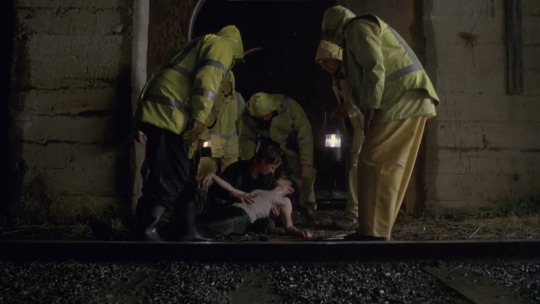
Figure 18. "All I can tell you, was that the heavens were falling. And the sound... it was incredible. It was like the Gods were rejoicing for what was done."
Backspatter Material (BM)

Figure 19. Distribution of Forward Spatter and Backspatter caused by a shot at a biological target. [1]
We hereby exclude the forward spatter, it is, the biological material projected fowards with the projectile (to the back of Nigel's head), for its little relevance, since we're not questioning the type of gun or ammunition used; we assume that Alex is describing a resonable scenario that matches with the actual damage done to Nigel. There are no consistent reasons to question this since everythings seems to support Alex's description of this.
BM comes from the combined forces of several interacting wound and ballistics effects. The collapse of the wound cavity and balance of resulting overpressure, the stream of liquid and tissue particles accelerated along the lateral surface of the projectile, the shot's contact and ejection of muzzle gases out of the entry wound from the powder cavity... Every surrouding surface must be investigated, that is, even the shotgun barrel's interior. This small ambience is fairly protected from external pertubations and houses BM from the shot. Considering the poximity with Nigel's face, we can almost assure to encounter biological material with DNA inside. The bellow mentioned study cites another work where a 9 mm pistol cointaned backspatter material from test targets even at a distance larger than 1 meter, much greater then the few inches that separated Nigel's face from the barrel. [1]
Matter of fact, this biological material can pass by processes of Organ Tissue Identification (OTI) and Body Fluid Identification (BFI) if Nigel's identity was at question, or if we desire to understand more profundly the projectile's damage caused to his skull/face/tissue. [1]

Figure 20. "None of what I've heard makes him a murderer."
So, how can we gather this up to develop the investigation? Utilizing only these two fundamental concepts, we can make a few assumptions.
The big question here is if whether or not Nigel's hands were present by Alex's when the trigger was pulled, which would lead the police to support or oppose Alex's narrative. Chemical examination with organic solvents (which won't cause preocupant harm to a dead body) and analytical methods could immediatly point to the presence of GSRs or biological/non biological BM. If Nigel's hands were elevated in his head level (or superior) in the instant of discharge, trace amounts of discussed metals/elements coming from the firing mechanism and ammunition, as weel as little to some biological material, would definetly be found in his hands and forearm skin since there was no clothing covering. Any substance found in his hands/forearm could be microanalytical compared to the ones present in Alex's hands, clothes and face as well. This could be done with really small samples of fresh skin. On the other hand, if Nigel's arms were lowered at the instant of discharge, we could still expect the presence of GSRs in his arms (yet, in less amounts) but the abssence of backspatter materials most certantly. This would classify Alex as a murderer without excuses, even if he alleged that Nigel asked for it.
In the scenario where Alex discharges at Nigel from a great distance (configuring simply murder) we could note the abssence of GSRs in every part of Nigel's body except for the targeted region (perhaps if they were at a greater distance to each other) and the presence of these GSRs in Alex, but in much higher concentration.
But the enviromnent's conditions are of primordial importance. Nigel and Alex stand in an open area, with considerable wind, heavy rain and gravel soil. The heavy rain could simply carry way much of these residues from Alex's body, clothes and Nigel's hands as well. Most GSR would probably be lost to those conditions and its deposite upon the soil's surface would be extremely hard to be quantitatively analized due to unknown degrees (elevated) of impurities and diverse materials and dirt present, but qualitative tests would still be valid.

The knowledge about the victim, crime scene, shooter, exact firegun and time of the tragic event allied with the fast action from authorities saves most of the police's efforts on identifiying and tracking down evidences. However, what remains still offers a challenge. The best evidence here, GSRs left by the discharge, would be of questionable help considering the presence of heavy rain in sight. Still, analitical quantities of them, if detected in Nigel's skin by proper chemical and espectroscopy-related analysis, can be used to comparate probable ammounts present in Alex's clothing and skin (despite the difficult of such). With that being said, the police would find themselves in a much more complex case of muder/assisted suicide, and further evidences and information about their relationship and recent whereabouts would ineviatably need to be extracted from external sources (such as parents, school's employess, close friends and students). Despite all this, Alex's final acting of removing Susan's body and disapearing from sight (not to mention the card left in Sally's car) immediatly sustent his guilt in a case where he already was the main suspect and basically confirmed criminal. And you know, breaking into a cemetery and extracting a corpse from its grave is definetly worth of some jail time. The Colbie's House Murder would certainly incriminate Alex for homicide as well, and the current Brotherhood's little political influence wouldn't prevent him from this destiny, as it appears. But the case is not over.
Further evidences were to be discussed, if it was not for the dissapearing of Alex Forbes.
The subject now roams unknowingly through England with mysterious intents. Its participation on the described case still lacks formal arguments and the Court should now approve his arrest warrant and search decree. Alex Forbes will most probably live to perpetrate the deluded fantasy responsable for the death of three young students in order to carry the sacred holy burden of an ancient templar bloodline.
Yet, we pray.


Who's the enemy now? We are.
4. Bibliography
[1] Euteneuer J, Courts C. Ten years of molecular ballistics-a review and a field guide. Int J Legal Med. 2021 Jul;135(4):1121-1136. doi: 10.1007/s00414-021-02523-0. Epub 2021 Feb 16. PMID: 33594457; PMCID: PMC8205864. [2] https://spotterup.com/how-ammo-works/ [3] Serol, M.; Ahmad, S.M.; Quintas, A.; Família, C. Chemical Analysis of Gunpowder and Gunshot Residues. Molecules 2023, 28, 5550. https://doi.org/10.3390/molecules28145550 [4] Guanchao Lan, Jing Li, Guangyuan Zhang, Jian Ruan, Zhiyan Lu, Shaohua Jin, Duanlin Cao, Jianlong Wang, Thermal decomposition mechanism study of 3-nitro-1,2,4-triazol-5-one (NTO): Combined TG-FTIR-MS techniques and ReaxFF reactive molecular dynamics simulations, Fuel, Volume 295, 2021, 120655, ISSN 0016-2361, https://doi.org/10.1016/j.fuel.2021.120655. [5] https://www.hunter-ed.com/national/studyGuide/How-the-Shotgun-Shoots/201099_92815/ [6] https://www.invaluable.com/auction-lot/era-410-ga-single-shot-break-action-shotgun-131-c-8284a72a5b [7] https://firearmland.com/item/1079096107 [8] https://www.letsgoshooting.org/resources/articles/shotgun/meet-the-shotgun/ [9] https://www.atf.gov/firearms/firearms-guides-importation-verification-firearms-ammunition-and-implements-war-top-break [10] Virginie Redouté Minzière, Céline Weyermann, Organic and inorganic gunshot residues on the hands, forearms, face, and nostrils of shooters 30 min after a discharge. Science & Justice, Volume 64, Issue 5, 2024, Pages 557-571, ISSN 1355-0306, https://doi.org/10.1016/j.scijus.2024.08.002. [11] Joshua Hallett, Michael Stolk, Michael Cook, K. Paul Kirkbride, Examination of gunshot residue arising from shotgun cartridges containing steel, bismuth or tungsten pellets. Forensic Science International, Volume 306, 2020, 110096, ISSN 0379-0738, https://doi.org/10.1016/j.forsciint.2019.110096. [12] https://www.bka.de/EN/OurTasks/SupportOfInvestigationAndPrevention/ForensicScience/PhysicalEvidence/Homicide/GunshotResidue/gunshotresidue_node.html [13] Francesco Saverio Romolo, Pierre Margot, Identification of gunshot residue: a critical review. Forensic Science International, Volume 119, Issue 2, 2001, Pages 195-211, ISSN 0379-0738, https://doi.org/10.1016/S0379-0738(00)00428-X. [14] Jalanti, T & Henchoz, P & Gallusser, Alain & Bonfanti, M.S.. (1999). The persistence of gunshot residue on shooters’ hands. Science & justice : journal of the Forensic Science Society. 39. 48-52. 10.1016/S1355-0306(99)72014-9.
Extra
random materials, take a look
1. Chemistry of Explosives (book pdf) https://link.springer.com/chapter/10.1007/978-1-4612-0589-0_5 2. ERA 410 GA video 1 https://www.youtube.com/watch?v=lGWm2aaWVAc&ab_channel=SteadFastCourage 3. ERA 410 GA video 2 https://www.youtube.com/watch?v=2S16C5Y6lxY&ab_channel=esquad540 4. Quick discussion about Smokeless Powder on r/guns https://www.reddit.com/r/guns/comments/1tawwm/things_i_want_you_to_know_about_smokeless_powder/#:~:text=Because%20of%20something%20called%20oxygen,and%20temperatures%2C%20leading%20to%20fouling. 5. A little on the kinetic energy of specific projectiles (everything applies here as well) https://nodoroc.com/d/node/20 6. A little more on ammunition Caliber https://www.globalsecurity.org/military/systems/munitions/bullets2-types.htm#google_vignette
For the sake of archieving, here are some shotguns I've separated to double check during my research until the Era 410 GA appeared. Curious enough, number 7, called "boito", appears to be another common name given to Era 410. Woops.
1. https://www.bidsquare.com/online-auctions/north-american-auction/victor-break-action-single-shot-12-ga-shotgun-4988316 2. https://www.crescentcityauctiongallery.com/auction-lot/stevens-arms-.410-gauge-single-shot-break-open-sh_9F84899825 3. https://palmettostatearmory.com/jts-shotguns-single-shot-410-bore-26-single-shot2.html 4. https://en.wikipedia.org/wiki/File:Stoeger-Coach-Gun.jpg 5. https://www.gunsinternational.com/guns-for-sale-online/shotguns/harrington-richardson-shotguns/h-r-bay-state-20-ga.cfm?gun_id=103017190 6. https://www.bankstowngunshop.com.au/product/12g-unknown-model-unknown-single-barrel-blued-wood-28-barrel-poor-condition/ 7. https://www.bankstowngunshop.com.au/product/410-boito-model-reuna-28-single-barrel-blued-timber-3-chamber-sec9622/ 8. https://www.bankstowngunshop.com.au/product/12g-harrington-richardson-model-1908-single-32-barrel-blued-wood/ 9. https://www.bankstowngunshop.com.au/product/12g-norinco-model-std-single-barrel-30-shotgun-great-condition/1 0. https://www.bankstowngunshop.com.au/product/12g-raick-freres-model-unknown-single-barrel-30-shotgun-belgium/ 11. https://gritrsports.com/henry-repeating-arms-single-shot-12ga-shotgun-h015-12 12. https://www.tmguns.co.uk/store/p1418/Tomas_Agote%2C_Eibar_12G_single_hammer_ejector_shotgun.html 13. https://www.tmguns.co.uk/store/p1659/Vanguard_Game%2FVermin_.410_hammer_ejector_single_barrel.html 14. https://www.tmguns.co.uk/store/p1290/Astra_Ciclope_12G_single_barrel_hammergun.html 15. https://www.tmguns.co.uk/store/p1883/Rossi_Game%2FVermin_20G_single_hammer_ejector_shotgun.html 16. https://en.wikipedia.org/wiki/File:Stevens_511_Shotgun.jpg 17. https://www.gunsinternational.com/guns-for-sale-online/shotguns/harrington-richardson-shotguns/harrington-richardson-44-smoothbore.cfm?gun_id=102901609
thank you for reading

#like minds#murderous intent#nigel colbie x alex forbes#nigel colbie#alex forbes#forensic science#analysis#Spotify
27 notes
·
View notes
Text

NASA's Glenn to test lunar air quality monitors aboard space station
As NASA prepares to return to the moon, studying astronaut health and safety is a top priority. Scientists monitor and analyze every part of the International Space Station crew's daily life—down to the air they breathe. These studies are helping NASA prepare for long-term human exploration of the moon and, eventually, Mars.
As part of this effort, NASA's Glenn Research Center in Cleveland is sending three air quality monitors to the space station to test them for potential future use on the moon. The monitors are slated to launch on Monday, April 21, aboard the 32nd SpaceX commercial resupply services mission for NASA.
Like our homes here on Earth, the space station gets dusty from skin flakes, clothing fibers, and personal care products like deodorant. Because the station operates in microgravity, particles do not have an opportunity to settle and instead remain floating in the air. Filters aboard the orbiting laboratory collect these particles to ensure the air remains safe and breathable.
Astronauts will face another air quality risk when they work and live on the moon—lunar dust.
"From Apollo, we know lunar dust can cause irritation when breathed into the lungs," said Claire Fortenberry, principal investigator, Exploration Aerosol Monitors project, NASA Glenn. "Earth has weather to naturally smooth dust particles down, but there is no atmosphere on the moon, so lunar dust particles are sharper and craggier than Earth dust. Lunar dust could potentially impact crew health and damage hardware."
Future space stations and lunar habitats will need monitors capable of measuring lunar dust to ensure air filtration systems are functioning properly. Fortenberry and her team selected commercially available monitors for flight and ground demonstration to evaluate their performance in a spacecraft environment, with the goal of providing a dust monitor for future exploration systems.
Glenn is sending three commercial monitors to the space station to test onboard air quality for seven months. All three monitors are small: no bigger than a shoe box. Each one measures a specific property that provides a snapshot of the air quality aboard the station. Researchers will analyze the monitors based on weight, functionality, and ability to accurately measure and identify small concentrations of particles in the air.
The research team will receive data from the space station every two weeks. While those monitors are orbiting Earth, Fortenberry will have three matching monitors at Glenn. Engineers will compare functionality and results from the monitors used in space to those on the ground to verify they are working as expected in microgravity. Additional ground testing will involve dust simulants and smoke.
Air quality monitors like the ones NASA is testing also have Earth-based applications. The monitors are used to investigate smoke plumes from wildfires, haze from urban pollution, indoor pollution from activities like cooking and cleaning, and how virus-containing droplets spread within an enclosed space.
Results from the investigation will help NASA evaluate which monitors could accompany astronauts to the moon and eventually Mars. NASA will allow the manufacturers to review results and ensure the monitors work as efficiently and effectively as possible. Testing aboard the space station could help companies investigate pollution problems here on Earth and pave the way for future missions to the Red Planet.
"Going to the moon gives us a chance to monitor for planetary dust and the lunar environment," Fortenberry said. "We can then apply what we learn from lunar exploration to predict how humans can safely explore Mars."
NASA commercial resupply missions to the International Space Station deliver scientific investigations in the areas of biology and biotechnology, Earth and space science, physical sciences, and technology development and demonstrations. Cargo resupply from U.S. companies ensures a national capability to deliver scientific research to the space station, significantly increasing NASA's ability to conduct new investigations aboard humanity's laboratory in space.
IMAGE: NASA researchers are sending three air quality monitors to the International Space Station to test them for potential future use on the moon. Credit: NASA/Sara Lowthian-Hanna
19 notes
·
View notes
Text
Educator – IOM Greece (Patras)
Position Title: Educator Duty Station: Patras, Greece Type of Appointment: Special Short-Term, Ungraded (up to 9 months) Job Schedule: Full-time, Day Shift Application Deadline: 5 June 2025, 20:59 (local time) Job ID: 14007 Recruitment Type: General Service (Local Recruitment Only) Empowering Young Lives: Become an Educator at IOM Greece Are you passionate about education and social inclusion? Do…
#Careers with the UN.#Entry-Level UN Jobs#Freelance UN Jobs#How to Apply for UN Jobs#Internship Opportunities with the UN#Part-Time UN Jobs#Remote UN Jobs#Temporary UN Jobs#UN Administration Jobs#UN Communications Jobs.UN Jobs#UN Communications Officer Jobs#UN Consultancy Jobs#UN Contract Jobs#UN Data Analyst Jobs#UN Data Science Jobs#UN Employment Opportunities#UN Engineering Jobs#UN Environmental Jobs#UN Field Officer Jobs#UN Health and Safety Jobs#UN Hiring#UN HR Jobs#UN Human Rights Officer Jobs#UN Humanitarian Jobs#UN International Jobs#UN Internship Vacancies.UN Project Manager Jobs#UN IT Jobs#UN Job Openings#UN Job Opportunities#UN Jobs Application Process
0 notes
Text
Cancelled Equipment: Lunar Application of a Spent S-IVB Stage (LASS)

"LASS vehicle landing legs and footpads."
In August 1965, NASA began the Apollo Applications Program (AAP) to develop science-based human spaceflight missions using hardware developed for the Apollo program following the first moon landing. They encouraged and invited proposals for new uses of Apollo hardware then under development. One such proposal came from the Douglas Company (DAC) and International Business Machines (IBM) for a modifying the Saturn S-IVB stage for use as an unmanned lunar logistics vehicle to carrier equipment to the moon to support extended human stays and/or a lunar base.

LASS vehicle launch configuration.
In their proposal, the Saturn IB/V S-IVB Stage would be modified with landing gear and other equipment. The Saturn Instrument Unit (IU), which sat on top of the S-IVB and was the computer system that controlled the entire rocket.


Procedure for LASS vehicle landing leg deployment and separation from the Saturn V S-II stage.
The mission was an unmanned, direct-flight, using an existing lunar beacon to obtain a precise landing location.
"The LASS required either a highly throttleable J-2 type engine (J-2X) or a moderately throttleable J-2S with RL-10 engines added to provide proper landing control.
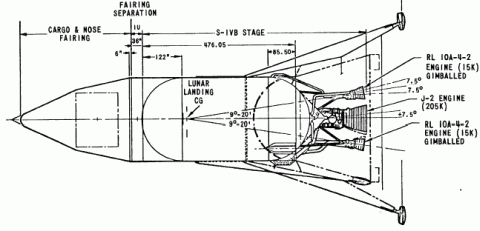

LASS vehicle engine and plumbing arrangement.
"DAC studied several configurations and recommended a vertical lander with a payload package on top. Landed payloads in the order of 27,300 pounds (12,380 kilograms) were claimed by DAC with the 1965 Saturn V capability. This payload was based on a more optimistic delta-V budget than used in other studies. However, the landed payload would still be substantial (7200 - 8600 kg) using the more conservative values."

"The LASS vehicle just before touchdown on the lunar surface. The illustration displays the position of the IU and, above it, the tapered LASS vehicle payload volume."
"After an unspecified period of time, astronauts would land near the LASS vehicle in an Apollo LM. The Douglas/IBM team provided few details about how the crew would interact with the LASS vehicle. They offered only a few vague suggestions concerning, for example, how astronauts in bulky space suits might ascend the approximately 60 feet (18.3 meters) to the top of the LASS vehicle to reach the payload. Neither did they describe how payload items would be moved from the top of the LASS vehicle to the surface, though they suggested that unspecified 'cargo & handling equipment' with a mass of 3100 pounds (1400 kilograms) would be available. These and other mysteries would no doubt have been addressed if NASA had opted to fund additional LASS studies.
The Douglas/IBM engineers did, however, define five typical LASS payload configurations and mission durations. All would feature lunar exploration hardware under consideration in 1966 for AAP lunar missions and would see IU navigational and communications electronics serve double-duty as experiment data support equipment.

Configuration 1 was most in keeping with the role of the LASS vehicle as a sequel to an S-IVB-derived laboratory in low-Earth orbit. The LASS vehicle's LH2 tank would be lined with 3940 pounds (1785 kilograms) of micrometeoroid shielding and thermal insulation before launch from Earth; this weight would be subtracted from the weight available for payload above the IU.

About 7700 pounds (3490 kilograms) of the payload above the IU would take the form of a two-man shelter similar to the SSESM proposed for the Earth-orbiting S-IVB laboratory. Life support gases and liquids and other expendables would account for 4500 pounds (2040 kilograms) of the payload. Experiment apparatus with a total weight of 500 pounds (227 kilograms), a 1000-pound (454-kilogram) unpressurized Lunar Scientific Survey Module (LSSM) rover, and a one-or-two-person Lunar Flying Unit (LFU) of unspecified weight would make up the balance of the payload.

Configuration 1 would see the two astronauts lower themselves into the LASS vehicle LH2 tank by unspecified means through an airlock in the shelter. The LH2 tank would then serve as either a laboratory or an emergency shelter. The crew would live in the LASS vehicle for up to 14 days before they reactivated their LM and returned to the Apollo CSM waiting in lunar orbit.
The other four LASS payload configurations would not make use of the LH2 tank, so the weight of the shielding and insulation surrounding it in Configuration 1 could be applied to payload above the IU. Configuration 2, with a 30-day lunar surface stay time, would include a 13,000-pound (5900-kilogram) four-man shelter, a 3800-pound (1725-kilogram) small (though possibly pressurized) rover, 4500 pounds (2040 kilograms) of science equipment, and 5700 pounds (2585 kilograms) of expendables. The Douglas/IBM team did not explain how four astronauts could reach the LASS vehicle on the Moon using the three-man CSM and two-man LM.

Configuration 3 would include a four-man shelter, an LSSM, science equipment, and 8500 pounds (3855 kilograms) of expendables. The four-person crew would remain on the Moon for 59 days. Configuration 4 would include a two-person shelter, a small rover, scientific equipment, and 11,000 pounds (4990 kilograms) of expendables. The crew would evenly divide their time during their 120-day lunar surface stay between the shelter and the small rover. Configuration 5 would include a two-person shelter, an LSSM, scientific equipment, and 13,800 pounds (6260 kilograms) of expendables. The crew would evenly divide their time during their 195-day stay between the shelter and the LSSM.


The Douglas/IBM team suggested that the astronauts might tip the roughly 60,000-pound (27,215-kilogram) LASS vehicle on its side to place its payload above the IU — which in this case would not include a shelter — close to the lunar surface. They did not, however, explain how the astronauts might accomplish this feat. They suggested that the crew could live inside their LM while they unloaded equipment from the tipped LASS vehicle and converted its LH2 tank into a shelter.
A LASS vehicle with more extensive modifications — for example, a large rectangular hole cut into its LH2 tank for mounting a telescope — might be tipped on its side and converted into a lunar surface astronomical observatory. Ultimately, multiple upright and tipped LASS vehicles might be dragged together to form a 'LASS Modular Lunar Base.' The Douglas/IBM engineers ended their report by declaring that 'LASS is envisioned to be the vehicle to support all lunar surface programs.'"
Information from Astronautix.com: link
Information from the "No Shortage of Dreams" blog: link
#Lunar Application of a Spent S-IVB Stage#LASS#S-IVB#Lunar Logistics Vehicle#Logistics Vehicle#Saturn IB#Saturn V#Rocket#NASA#Apollo Program#Apollo Applications Program#Cancelled#Proposal#undated#1965#1966#my post
21 notes
·
View notes
Text
Paleontology Job Opening!
If anyone is looking for a paleontology job, this one in the Green River Formation in Wyoming is hiring! It's a lot of 52-MYA fish. TONS of fish. Very occasionally, there's other stuff like bats, birds, and very early horse ancestors.
$19/hour
Full time with federal benefits
App due November 25, 2024 or when they receive 80 applications (whichever comes first, so hurry!) Requirements:
One year of experience required (paid or unpaid, professional or volunteer) in "the fields of paleontology, geophysics, or geology; assisting fossil preparation, field work in paleontology, paleontology research, paleontology database management, paleontology monitoring, paleo art, or specimen management of fossils; assisting with natural resources research projects; compiling and analyzing scientific data into reports; operating complex sampling, monitoring, and laboratory equipment; or using computer programs such as databases to compile, store, retrieve, analyze and report resource management data. Experience as a laboratory mechanic or in a trade or craft may be credited as specialized experience when the work was performed in close association with physical scientists or other technical personnel and provided intensive knowledge of appropriate scientific principles, methods, techniques, and precedents."
Successful completion of at least a full 4-year course of study leading to a bachelor's degree (a) with major study in an appropriate field of physical science, such as paleontology, geology, earth science, earth history or (b) that included at least 24 semester hours in any combination of courses such as physical science, engineering, or any branch of mathematics except for financial and commercial mathematics.
I don't know if paleontologists usually have to have higher levels of education, but I think this job is called "physical technician (paleontology)" to evade that.
If you're interested, go ahead and send in an application sooner rather than later. You can always withdraw later.
This is very close to me, so if you have questions about life here (that aren't easily Googlable) I'm happy to help! It's quite rural. If you're wondering what the rental market looks like, here's a Facebook group where people post rentals. I'm mostly JTM (just the messenger) but I may have a little more insight.

40 notes
·
View notes
Text
Summer 2025 Game Development Student Internship Roundup, Part 2
Internship recruiting season has begun for some large game publishers and developers. This means that a number of internship opportunities for summer 2025 have been posted and will be collecting applicants. Internships are a great way to earn some experience in a professional environment and to get mentorship from those of us in the trenches. If you’re a student and you have an interest in game development as a career, you should absolutely look into these.
This is part 2 of this year's internship roundup. [Click here for part 1].

Associate Development Manager Co-op/Internship - Summer 2025 (Sports FC QV)
Game Product Manager Intern (Summer 2025)
Music Intern
EA Sports FC Franchise Activation Intern
Associate Character Artist Intern
Client Engineer Intern
Visual Effects Co-Op
Associate Environment Artist Co-Op (Summer 2025)
Game Design Intern (Summer 2025)
Game Design Co-Op (Summer 2025)
Concept Art Intern - Summer 2025
UI Artist Intern - Summer 2025 (Apex Legends)
Assistant Development Manager Intern
Global Audit Intern
Creator Partnerships Intern - Summer 2025
Technical Environment Art Intern - Summer 2025 (Apex Legends)
Intern, FC Franchise Activation, UKI
Tech Art Intern - Summer 2025 (Apex Legends)
Software Engineer Intern
UI Artist Intern
Game Designer Intern
FC Franchise Activation Intern
Software Engineer Intern
Product UX/UI Designer
Software Engineer Intern
Enterprise, Experiences FP&A Intern
Game Designer Intern
Software Engineer Intern
Development Manager Co-Op (Summer 2025)
Software Engineer Intern
PhD Software Engineer Intern
Character Artist Intern
2D Artist Intern - Summer 2025
Software Engineer Intern (UI)
Entertainment FP&A Intern
Game Design Co-Op (Summer 2025)
Data Science Intern
Production Manager Intern
Software Engineer Intern
Channel Delivery Intern
FC Pro League Operations Intern
World Artist Intern
Experience Design Co-Op
Media and Lifecycle Planning Intern
Software Engineer Intern - Summer 2025
Software Engineer Intern - Summer 2025
Intern, FC Franchise Activation, North America
Creative Copywriter Intern
Game Design Intern
Social Community Manager Co-Op
Business Intelligence Intern
Software Engineer Intern (F1)
Total Rewards Intern - MBA level

Intern - Office Administration
Digital Communication Assistant – Internship (6 months) february/march 2025 (W/M/NB)
International Events Assistant - Stage (6 mois) Janvier 2025 (H/F/NB)
Intern Cinematic Animator
Research Internship (F/M/NB) - Neural Textures for Complex Materials - La Forge
Research Internship (F/M/NB) - Efficient Neural Representation of Large-Scale Environments - La Forge
Research Internship (F/M/NB) – High-Dimensional Inputs for RL agents in Dynamic Video Games Environments - La Forge
Research Internship (F/M/NB) – Crafting NPCs & Bots behaviors with LLM/VLM - La Forge
3D Art Intern
Gameplay Programmer Intern
Intern Game Tester
Etudes Stratégiques Marketing – Stage (6 mois) Janvier 2025 (F/H/NB)
Localization Assistant– Stage (6 mois) Avril 2025 (F/H/NB)
Fraud & Analyst Assistant - Stage (6 mois) Janvier 2025 (F/H/NB)
Payment & Analyst Assistant - Stage (6 mois) Janvier 2025 (F/H/NB)
Media Assistant – Stage (6 mois) Janvier 2025 (F/H/NB)
IT Buyer Assistant - Alternance (12 mois) Mars 2025 (H/F/NB)
Event Coordinator Assistant - Stage (6 mois) Janvier 2025 (H/F/NB)
Communication & PR Assistant - Stage (6 mois) Janvier 2025 (F/H/NB)
Brand Manager Assistant - MARKETING DAY - Stage (6 mois) Janvier 2025 (F/N/NB)
Manufacturing Planning & Products Development Assistant - Stage (6 mois) Janvier 2025 (H/F/NB)
Retail Analyst & Sales Administration Assistant - Stage (6 mois) Janvier 2025 (H/F/NB)
UI Designer Assistant - Stage (6 mois) Janvier 2025 (F/M/NB)
Esports Communication Assistant
Machine Learning Engineer Assistant – Stage (6 mois) Janvier/Mars 2025 (F/H/NB)
Social Media Assistant – Stage (6 mois) Janvier 2025 (F/H/NB)
36 notes
·
View notes
Text
The Four Horsemen of the Digital Apocalypse
Blockchain. Artificial Intelligence. Internet of Things. Big Data.
Do these terms sound familiar? You have probably been hearing some or all of them non stop for years. "They are the future. You don't want to be left behind, do you?"
While these topics, particularly crypto and AI, have been the subject of tech hype bubbles and inescapable on social media, there is actually something deeper and weirder going on if you scratch below the surface.
I am getting ready to apply for my PhD in financial technology, and in the academic business studies literature (Which is barely a science, but sometimes in academia you need to wade into the trash can.) any discussion of digital transformation or the process by which companies adopt IT seem to have a very specific idea about the future of technology, and it's always the same list, that list being, blockchain, AI, IoT, and Big Data. Sometimes the list changes with additions and substitutions, like the metaverse, advanced robotics, or gene editing, but there is this pervasive idea that the future of technology is fixed, and the list includes tech that goes from questionable to outright fraudulent, so where is this pervasive idea in the academic literature that has been bleeding into the wider culture coming from? What the hell is going on?
The answer is, it all comes from one guy. That guy is Klaus Schwab, the head of the World Economic Forum. Now there are a lot of conspiracies about the WEF and I don't really care about them, but the basic facts are it is a think tank that lobbies for sustainable capitalist agendas, and they famously hold a meeting every year where billionaires get together and talk about how bad they feel that they are destroying the planet and promise to do better. I am not here to pass judgement on the WEF. I don't buy into any of the conspiracies, there are plenty of real reasons to criticize them, and I am not going into that.
Basically, Schwab wrote a book titled the Fourth Industrial Revolution. In his model, the first three so-called industrial revolutions are:
1. The industrial revolution we all know about. Factories and mass production basically didn't exist before this. Using steam and water power allowed the transition from hand production to mass production, and accelerated the shift towards capitalism.
2. Electrification, allowing for light and machines for more efficient production lines. Phones for instant long distance communication. It allowed for much faster transfer of information and speed of production in factories.
3. Computing. The Space Age. Computing was introduced for industrial applications in the 50s, meaning previously problems that needed a specific machine engineered to solve them could now be solved in software by writing code, and certain problems would have been too big to solve without computing. Legend has it, Turing convinced the UK government to fund the building of the first computer by promising it could run chemical simulations to improve plastic production. Later, the introduction of home computing and the internet drastically affecting people's lives and their ability to access information.
That's fine, I will give him that. To me, they all represent changes in the means of production and the flow of information, but the Fourth Industrial revolution, Schwab argues, is how the technology of the 21st century is going to revolutionize business and capitalism, the way the first three did before. The technology in question being AI, Blockchain, IoT, and Big Data analytics. Buzzword, Buzzword, Buzzword.
The kicker though? Schwab based the Fourth Industrial revolution on a series of meetings he had, and did not construct it with any academic rigor or evidence. The meetings were with "numerous conversations I have had with business, government and civil society leaders, as well as technology pioneers and young people." (P.10 of the book) Despite apparently having two phds so presumably being capable of research, it seems like he just had a bunch of meetings where the techbros of the mid 2010s fed him a bunch of buzzwords, and got overly excited and wrote a book about it. And now, a generation of academics and researchers have uncritically taken that book as read, filled the business studies academic literature with the idea that these technologies are inevitably the future, and now that is permeating into the wider business ecosystem.
There are plenty of criticisms out there about the fourth industrial revolution as an idea, but I will just give the simplest one that I thought immediately as soon as I heard about the idea. How are any of the technologies listed in the fourth industrial revolution categorically different from computing? Are they actually changing the means of production and flow of information to a comparable degree to the previous revolutions, to such an extent as to be considered a new revolution entirely? The previous so called industrial revolutions were all huge paradigm shifts, and I do not see how a few new weird, questionable, and unreliable applications of computing count as a new paradigm shift.
What benefits will these new technologies actually bring? Who will they benefit? Do the researchers know? Does Schwab know? Does anyone know? I certainly don't, and despite reading a bunch of papers that are treating it as the inevitable future, I have not seen them offering any explanation.
There are plenty of other criticisms, and I found a nice summary from ICT Works here, it is a revolutionary view of history, an elite view of history, is based in great man theory, and most importantly, the fourth industrial revolution is a self fulfilling prophecy. One rich asshole wrote a book about some tech he got excited about, and now a generation are trying to build the world around it. The future is not fixed, we do not need to accept these technologies, and I have to believe a better technological world is possible instead of this capitalist infinite growth tech economy as big tech reckons with its midlife crisis, and how to make the internet sustainable as Apple, Google, Microsoft, Amazon, and Facebook, the most monopolistic and despotic tech companies in the world, are running out of new innovations and new markets to monopolize. The reason the big five are jumping on the fourth industrial revolution buzzwords as hard as they are is because they have run out of real, tangible innovations, and therefore run out of potential to grow.
#ai#artificial intelligence#blockchain#cryptocurrency#fourth industrial revolution#tech#technology#enshittification#anti ai#ai bullshit#world economic forum
32 notes
·
View notes